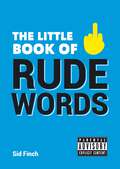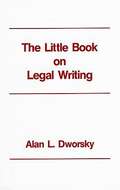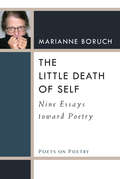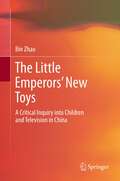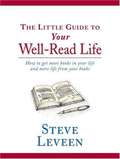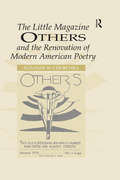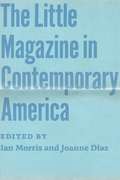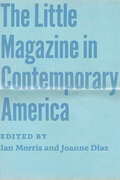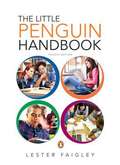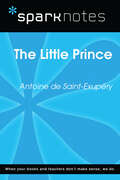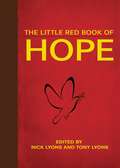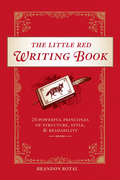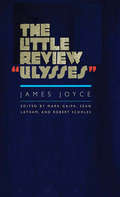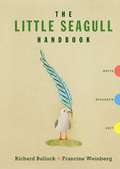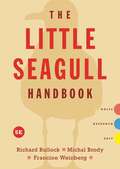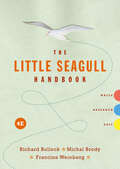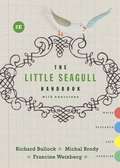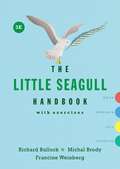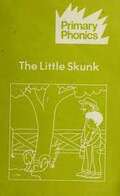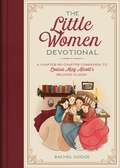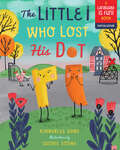- Table View
- List View
The Little Book of Rude Words (The\little Book Of Ser.)
by Sid FinchSwearing is an art form, and with this handy collection of obscenities you can be the Picasso of profanity. Bursting with obnoxious insults and filthy names for unmentionable acts, The Little Book of Rude Words will leave you shocked and tickled by how creatively crude our language can be.
The Little Book on Legal Writing
by Alan L. DworskyThis book is geared to the kind of writing first-year law students do in a standard legal writing course: memorandums and briefs. However, almost all the advice given applies to other kinds of legal writing as well, such as contracts and pleadings. In fact, much of the advice applies to nonfiction writing in general, because good legal writing is simply good writing. Each subject is broken down into simple, concise sections, making The Little Book on Legal Writing an excellent title for any professor s legal writing course.
The Little Database: A Poetics of Media Formats (Electronic Mediations #64)
by Daniel Scott SnelsonA poetics for reading the everyday objects that populate a hard drive Bespoke online archives like PennSound and Eclipse host an astounding array of &“old media&” artifacts, posing a handcrafted counterpoint to the immense databases aggregated by digital titans like Google and Facebook. In The Little Database, Daniel Scott Snelson argues for the significance of these comparatively &“small&” collections, exploring how digital archives dramatically transform the artifacts they host and how they might help us better understand our own private collections in turn. Examining curated collections such as Textz, UbuWeb, and the Electronic Poetry Center, Snelson explores media-specific works by poets and artists, including William Carlos Williams, Tracie Morris, bill bissett, Nam June Paik, and Vicki Bennett. He develops creative tools and contingent methods for reading cultural data, whether found on the internet or in our own collections of TXT, JPG, MP3, and MOV artifacts, presenting case studies to show how these objects have come to find revised meaning in their digital contexts. Along the way, experimental poetic interludes give readers practical entry points into the creative practice of producing new meanings in any given little database. Inventive and interdisciplinary, The Little Database grapples with the digitized afterlives of cultural objects, showing how the past is continually reconfigured to shape the present. It invites readers to find playful and personal means for unpacking their own data collections, in the process discovering idiosyncratic ways to explore and connect with digital archives. Retail e-book files for this title are screen-reader friendly with images accompanied by short alt text and/or extended descriptions.
The Little Death of Self: Nine Essays toward Poetry
by Marianne BoruchThe line between poetry (the delicate, surprising not-quite) and the essay (the emphatic what-about and so-there!) is thin, easily crossed. Both the poem and the essay work beyond a human sense of time. Both welcome a deep mulling-over, endlessly mixing image and idea and running with scissors; certainly each distrusts the notion of premise or formulaic progression. The essays in The Little Death of Self emerged by way of an odd detail or bothersome question that would not quit— Why does the self grow smaller as the poem grows enormous, or as quiet as a half-second of genuine discovery? Why does closure in a poem so often mean keep going, so what if the world is ending! Must we stalk the poem or does the poem stalk us until the world clicks open? Boruch’s intrepid curiosity led her to explore fields of expertise about which she knew little; then, perhaps through her reading, observation, and conversations with thoughtful people, she knew enough to be forgiven for delving into areas such as aviation, music, anatomy, history, medicine, photography, fiction, neuroscience, physics, anthropology, painting, and drawing. There’s an addiction to metaphor here, an affection for image, sudden turns of thinking, and the great subjects of poetry: love, death, time, knowledge. There’s amazement at the dumb luck of staying long enough in an inkling to make it a thought or a poem at all. Poets such as Keats, Stevens, Frost, Plath, Auden, and Bishop, along with painters, inventors, doctors, scientists, composers, musicians, neighbors, friends, and family—all traffic blatantly or under the surface—and one gets a glimpse of such fellow travelers now and then. The essays collected in The Little Death of Self are meditations toward poetry by a poet who finds this mysterious genre the weirdest, most compelling of all human ways to imagine—or fathom—the great world.
The Little Emperors’ New Toys
by Bin ZhaoDrawing on original research I conducted in the late 1980s, the book argues for a critical approach to the study of children and television. It begins with critical reappraisals of previous empiricist and interpretative studies to set the ground for a different theoretical inquiry which links biography with history. The situated activity of children's television viewing therefore has to be related to the broader historical and cultural formations in post-Mao China. By way of a methodological pluralism of questionnaire survey, in-depth interviews and observation, the book provides the reader with a thorough critical analysis of the rise of the new commercial ethic in Chinese society in general, and in the sector of media and communications in particular, at the very historical turning point of the late 1980s. Soon after that, Deng Xiaoping made his significant tour to south China, reckoning a big step forward towards further liberalization and started to form a brave new world in China ever since.
The Little Guide to Your Well-Read Life
by Steve Leveen"Perfect for all of us who can never get enough time with good books. It not only urges us to indulge deeply and often, it shows us how."-Myra Hart, professor, Harvard Business School. "Readers and want-to-be readers will be encouraged by the advice to read more, more widely and more systematically."-Michael Keller, university librarian, Stanford University. "An ideal gift for both sporadic and relentless readers."-James Mustich Jr., publisher of A Common Reader. "A worthy addition to even the most well-stocked personal library."-Ross King, author of Michelangelo & The Pope's Ceiling. Do not set out to live a well-read life but rather your well-read life. No one can be well-read using someone else's reading list. Unless a book is good for you, you won't connect with it and gain from it. Just as no one can tell you how to lead your life, no one can tell you what to read for your life. How do readers find more time to read? In The Little Guide to Your Well-Read Life, Steve Leveen offers both inspiration and practical advice for bibliophiles on how to get more books in their life and more life from their books. His recommendations are disarmingly refreshing, as when he advises when not to read a book and why not to feel guilty if you missed reading all those classics in school. He helps readers reorganize their bookshelves into a Library of Candidates that they actively build and a Living Library of books read with enthusiasm, and he emphasizes the value of creating a Bookography, or annotated list of your reading life. Separate chapters are devoted to the power of audio books and the merits of reading groups. The author himself admits he came "late to the bookshelf," making this charming little guide all the more convincing.
The Little Magazine Others and the Renovation of Modern American Poetry
by Suzanne W. ChurchillSuzanne Churchill's well-researched and superbly crafted study is the first book-length treatment of Others, an important and neglected little magazine that served as a laboratory for modernist poetic experimentation. In discussions of influential poets such as Mina Loy, Marianne Moore, and William Carlos Williams, whose careers Others helped launch, Churchill counters the notion of Modernism as aesthetically self-isolating and socially disengaged. Rather, she traces a correspondence between formal innovation and social change in American modernist poetry and argues that this dimension of modernist formalism is lost when poems are studied in isolation. Others provides a framework for reassessing the scope and significance of modernist formalism. The little magazine not only anchors modernist poetry in a social context but also leads to new insight into major modernist texts. Churchill's commitment to her subject's broad cultural contexts makes her book important for students and teachers of Modernism as well as for those working in the fields of American poetry and poetics, gender studies, queer theory, periodical studies, and cultural studies.
The Little Magazine in Contemporary America
by Ian Morris Joanne DiazLittle magazines have often showcased the best new writing in America. Historically, these idiosyncratic, small-circulation outlets have served the dual functions of representing the avant-garde of literary expression while also helping many emerging writers become established authors. Although changing technology and the increasingly harsh financial realities of publishing over the past three decades would seem to have pushed little magazines to the brink of extinction, their story is far more complicated. In this collection, Ian Morris and Joanne Diaz gather the reflections of twenty-three prominent editors whose little magazines have flourished over the past thirty-five years. Highlighting the creativity and innovation driving this diverse and still vital medium, contributors offer insights into how their publications sometimes succeeded, sometimes reluctantly folded, but mostly how they evolved and persevered. Other topics discussed include the role of little magazines in promoting the work and concerns of minority and women writers, the place of universities in supporting and shaping little magazines, and the online and offline future of these publications. Selected contributors Betsy Sussler, BOMB; Lee Gutkind, Creative Nonfiction; Bruce Andrews, L=A=N=G=U=A=G=E; Dave Eggers, McSweeney’s; Keith Gessen, n+1; Don Share, Poetry; Jane Friedman, VQR; Amy Hoffman, Women’s Review of Books; and more.
The Little Magazine in Contemporary America
by Ian Morris Joanne DiazLittle magazines have often showcased the best new writing in America. Historically, these idiosyncratic, small-circulation outlets have served the dual functions of representing the avant-garde of literary expression while also helping many emerging writers become established authors. Although changing technology and the increasingly harsh financial realities of publishing over the past three decades would seem to have pushed little magazines to the brink of extinction, their story is far more complicated. In this collection, Ian Morris and Joanne Diaz gather the reflections of twenty-three prominent editors whose little magazines have flourished over the past thirty-five years. Highlighting the creativity and innovation driving this diverse and still vital medium, contributors offer insights into how their publications sometimes succeeded, sometimes reluctantly folded, but mostly how they evolved and persevered. Other topics discussed include the role of little magazines in promoting the work and concerns of minority and women writers, the place of universities in supporting and shaping little magazines, and the online and offline future of these publications. Selected contributors Betsy Sussler, BOMB; Lee Gutkind, Creative Nonfiction; Bruce Andrews, L=A=N=G=U=A=G=E; Dave Eggers, McSweeney’s; Keith Gessen, n+1; Don Share, Poetry; Jane Friedman, VQR; Amy Hoffman, Women’s Review of Books; and more.
The Little Penguin Handbook, Fourth Edition
by Lester FaigleyThe Little Penguin Handbook is a rich resource for students in composition courses and in courses across the curriculum. With more visuals and sample documents, this handy reference gives students just what they need to know about the writing and research processes, while providing extensive coverage of documentation and grammar.
The Little Prince (SparkNotes Literature Guide Series)
by SparkNotesThe Little Prince (SparkNotes Literature Guide) by Antoine Saint-Exupery Making the reading experience fun! Created by Harvard students for students everywhere, SparkNotes is a new breed of study guide: smarter, better, faster. Geared to what today's students need to know, SparkNotes provides: *Chapter-by-chapter analysis *Explanations of key themes, motifs, and symbols *A review quiz and essay topicsLively and accessible, these guides are perfect for late-night studying and writing papers
The Little Red Book of Hope (Little Red Books)
by Nick Lyons Tony LyonsHope is an interesting thing. Some think it’s foolish, often misplaced, and at rarer times devastating; but more agree that hope is an integral and beautiful part of life, something that implicitly makes us human. We’re always hoping for something—for change, for improvement, or to find peace of mind amid life’s bustling demands. These things are often the subjects of our deepest desires, those things that can bring us true happiness. Fortunately for all of us who count ourselves among the hopeful, there has been plenty of wisdom bestowed from some of the greatest minds and noteworthy individuals throughout history, including:Albert Einstein Albert CamusBarack Obama Benjamin FranklinJohn Lennon George Bernard ShawAbraham Lincoln And many others! The Little Red Book of Hope is an inspired collection of uplifting thoughts about what it is that allows us to persevere; about the primacy of the human spirit, and ultimately, about the redemptive power and vitality of hope.
The Little Red Cat Who Ran Away and Learned His ABC's (the Hard Way): Who Ran Away From Home and Learned His ABC's the Hard Way
by Patrick McdonnellBestselling and award-winning artist Patrick McDonnell uses the ABC's to tell a hilarious, high-energy alphabetical adventure.It starts with an ALLIGATOR and a BEAR chasing a CAT. When a DRAGON (and a chicken and an egg!) join in pursuit, things start to get REALLY interesting. A wild and wacky chase through snow and ice, and to jungles and over mountaintops, leads the whole crew to a wonderful realization: They're better off as friends.From New York Times bestselling author and Caldecott Honor recipient Patrick McDonnell comes an exciting new take on the alphabet book for everyone who has ever wondered what's just beyond the front door.
The Little Red Hen class 2 - MIE
by Mauritius Institute of Education"The Little Red Hen" adapted by the English Department at the Mauritius Institute of Education for Grade 2 presents a classic story of diligence and cooperation. The tale revolves around a resourceful little red hen living on a farm, seeking assistance from her friends—a dog, a cat, and a duck—in various tasks from planting seeds to baking bread. However, each time she asks for help, her friends decline, preoccupied with their own pursuits. Undeterred, the hen independently tends to the chores, culminating in baking a loaf of bread, which she then chooses to enjoy alone. Through engaging illustrations and simple narrative, the story underscores the values of hard work, self-reliance, and the consequences of not lending a hand. The book, designed for interactive classroom sessions, encourages critical thinking among young readers by prompting discussions on sharing, teamwork, and the importance of helping others, fostering essential literacy skills and moral understanding among Grade 2 students.
The Little Red Writing Book: 20 Powerful Principles Of Structure, Style And Readability
by Brandon RoyalThere's no need to fear the big, bad world of writing with The Little Red Writing Book in hand. Brimming with clever advice, this book offers writers, students, and business professionals a concise guide to penning strong and effective work for all occasions. The Little Red Writing Book is designed for visual appeal and ease of use. Elegant yet practical, it will be an intriguing, inviting reference you'll turn to again and again. Author Brandon Royal offers concise explanations and nonintimidating instruction based on the four pillars of sound writing -- structure, style, readability, and grammar. His discussion centers on 20 immutable writing principles as well as 30 commonly encountered rules of grammar. A wealth of examples, charts, and engaging exercises make The Little Red Writing Book an invaluable guide for anyone who wants to master those skills that will make a good writer even better. Book jacket.
The Little Review "Ulysses"
by James Joyce Robert Scholes Sean Latham Mark GaipaJames Joyce's Ulysses first appeared in print in the pages of an American avant-garde magazine, The Little Review, between 1918 and 1920. The novel many consider to be the most important literary work of the twentieth century was, at the time, deemed obscene and scandalous, resulting in the eventual seizure of The Little Review and the placing of a legal ban on Joyce's masterwork that would not be lifted in the United States until 1933. For the first time, The Little Review "Ulysses" brings together the serial installments of Ulysses to create a new edition of the novel, enabling teachers, students, scholars, and general readers to see how one of the previous century's most daring and influential prose narratives evolved, and how it was initially introduced to an audience who recognized its radical potential to transform Western literature. This unique and essential publication also includes essays and illustrations designed to help readers understand the rich contexts in which Ulysses first appeared and trace the complex changes Joyce introduced after it was banned.
The Little Seagull Handbook
by Richard Bullock Francine WeinbergThe Little Seagull Handbook offers help with specific kinds of writing that college students are expected to undertake.
The Little Seagull Handbook (Fifth Edition)
by Richard Bullock Francine Weinberg Michal BrodyWrite. Research. Edit. Everything students need in an affordable handbook they truly use. The Little Seagull Handbook is the #1 best-selling handbook because it’s easy to use, easy to afford, and covers everything students need—no more, no less. Intuitive organization, color coding, and jargon-free instruction for common kinds of writing make it a reference tool that student writers truly rely on. This edition includes new advice designed for developing writers, new advice for using inclusive language, and two new complete model student essays using MLA and APA documentation. This purchase offers access to the digital ebook only.
The Little Seagull Handbook with Exercises
by Richard Bullock Francine Weinberg Michal BrodyThe #1 brief handbook—and one that students say improves their writing Affordable and easy to use, The Little Seagull Handbook is the #1 brief handbook because students say it has a positive impact on their writing. Intuitive organization, color-coding, and jargon-free instruction for common kinds of writing make it a reference tool that student writers truly use. This edition includes NEW advice for conducting research as it’s done online today, NEW student model essays, and a NEW chapter on writing summary/response essays. This purchase offers access to the digital ebook only.
The Little Seagull Handbook with Exercises (Second Edition)
by Richard Bullock Francine Weinberg Michal BrodyThe Little Seagull Handbook offers the kind of succinct advice students need about grammar, punctuation, documentation, and the writing process-an in addition, it covers the kinds of writing they are most often assigned-reports, analyses, narratives, and more. The second edition includes unique help for students whose primary language is not English. Available in two versions-with and without exercises.
The Little Seagull Handbook with Exercises (Third Edition)
by Richard Bullock Francine Weinberg Michal BrodyMost handbooks include chapters on various general writing topics (e.g., the writing process or the elements of an argument), but few cover the specific kinds of writing students are assigned to do. The Little Seagull has chapters on reports, analyses, and all the other genres that college students are most often assigned. And because it's so small, so easy to use, and so affordable, it's proven to be a popular alternative to larger (and much more costly) handbooks. The third edition adds a new section on editing the errors that matter―and the option to include free access to InQuizitive for Writers, which provides practice in editing the same errors.
The Little Skunk (Primary Phonics #Set 4 Book 4)
by Barbara W. MakarA systematic, phonics-based early reading program that includes: the most practice for every skill, decodable readers for every skill, and reinforcement materials--help struggling students succeed in the regular classroom
The Little Women Devotional: A Chapter-by-Chapter Companion to Louisa May Alcott's Beloved Classic
by Rachel DodgeDevotional Inspiration from the Lives of Meg, Jo, Beth, and Amy The Little Women Devotional offers lovely inspiration that explores the themes of faith, family, contentment, wisdom, and joy in the classic Louisa May Alcott novel, cherished by generations of readers. Each reading corresponds with a chapter from the book and invites you to embrace God's guiding hand in your life as His cherished daughter. This beautiful chapter-by-chapter devotional includes original artwork throughout, and each reading includes examples from the novel, scripture, life application, and prayers perfect for groups, book clubs, or personal reflection.
The Little i Who Lost His Dot (Language Is Fun! #1)
by Kimberlee GardLittle i can't wait to meet his friends at school, but there's just one problem: he can't find his dot anywhere! 2019 Colorado Book Awards recipient
